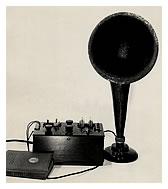History | WBT's Technical History
Perspective
Once President Dwight Eisenhower and Soviet Union Premier Nikita Krushchev held a summit conference in some European palace. Only one member of the press was to be admitted inside to cover the proceedings, so an American newspaper photographer was chosen by the press pool to be their sole representative. When the meeting concluded and the photographer emerged, the gaggle of reporters crowded around him to learn all the details. "What was it like in there?" asked an anxious newsman. The photographer thought for a short moment then replied, "It was about an F8."
(For those unacquainted with the mechanics of photography, F8 is an exposure setting for a camera lens.)
Our point here is there are different perspectives to everything. The answer you get to any question depends on whom you ask. The following history of WBT is from the perspective of WBT transmitter engineer Bill Hicklin. (Who would ever have expected to read any history of WBT that includes the phrase "30 or 40 quart fruit jars filled with borax and water"?)
The article was part of a 1955 Mikes and Dollies newsletter, included here in its entirety. We're bringing it to the forefront for, amidst all the talk of fruit jars, oscillators and rectifiers, there are some important milestones to be noted. Plus it gives us an opportunity to present some old photos that are pertinent to the story.
AM Transmitter—Then and Now
by Bill Hicklin
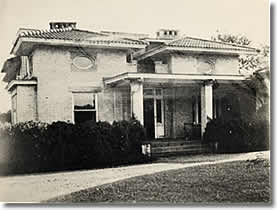 |
| WBT's first home: The Laxton home at the corner of Charlotte's Mecklenburg and Belvedere Avenues in the Plaza-Midwood neighborhood. |
The station that was to become WBT began operation as an experimental station known as 4XD in December of 1920, in the home of Mr. Fred Laxton, just across from the entrance to the Charlotte Country Club. The house is still in existence. Pioneers and originators were Mr. Laxton, Mr. Frank Bunker (both deceased) and Mr. Earl Gluck (at present the very alive chief executive of WSOC).
On April 10, 1922, the station was granted a commercial broadcast license. Mr. Laxton retired and the station moved to the top floor of the Independence Building. They used the 13 wire fan-type antenna supported by two poles on the roof. The only two tubes in the station were the 2 type 203's which gave an output of 100 watts. Later the power was increased by substituting type 204 tubes.
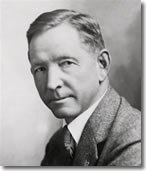 |
| Fred Laxton |
For the information of the technicians, these two tubes were the oscillator-power output stage which fed the antenna and were modulated by a transformer whose secondary was connected from the tube's cathode to ground. The primary of the transformer was in series with the microphone.
This was called "Magnetic Modulation." The maximum amount of modulation possible was estimated to be not more than 20%. The rectifier for the plate voltage consisted of about 30 or 40 quart fruit jars filled with borax and water in which were emersed (sic) lead and aluminum electrodes for rectifier action. All of this apparatus was home made except the tubes and the transformer, which were RCA products. Our present transmitter cost around $100,000 and has 30 tubes, with an estimated 1,000 or more tubes used in auxiliary equipment and at the AM studio in the control room.
In 1925 the station was bought by Mr. C. C. Coddington who was the local Buick dealer. (WBT, Watch Buick Travel). A used transmitter, Western Electric type WE6A, and antenna towers were purchased from a firm that had gone broke in the land boom at Boca Raton, Fla. They were installed atop the Coddington Building, 500 W. Trade Street. The power was 500 watts and was later increased to 1,000 watts. The station was on the air from noon until 1 p.m., and from about 7 p.m. until 10 p.m. on weekdays, with special hours for church service on Sunday.
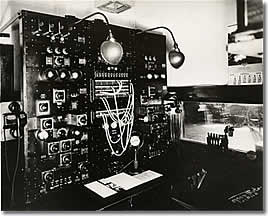 |
| The calendar page on the wall of WBT's old control room is for April 1929. Tom Callahan, an engineer friend to many of us, sat at this very control panel and turned these knobs. |
There were 6 employes of the station in 1928. Mr. Hank Burwell was the manager, program department and salesman. He had one secretary and four engineers who were Mr. Earl Gluck, Mr. Paul Rosecrans, Mr. Ralph Reid and Mr. T. B. Callahan.
Late in 1928 a new building was finished in a cotton field on the present site of the AM transmitter. The transmitter, built by General Electric and sold by RCA, was a type 5A, 5,000 watts. It was the second broadcast transmitter ever sold by RCA with that much power. The first one had gone to Canada.
The first antenna on the present transmitter site was supported by a cable stretched between two towers.
In 1929 the station was purchased by CBS and in 1932 the transmitter building was almost tripled in size. A 50B transmitter unit was added to the 5A transmitter and the power increased to 25,000 watts.
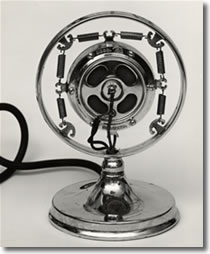 |
| An early WBT spring-mounted microphone made by the Shure Corporation, which is still in the microphone business. |
In 1934 the power was increased to 50,000 watts, using the same transmitter and a new tower was put into use as the antenna. This tower sat on an insulator, the tower itself being the antenna.
On December 1, 1942, a cyclone broke 168 feet from the top of this 435 foot high structure. The wires carrying the power to the antenna burned in two, but the transmitter was off the air for only an hour and a half. The next day an extra long wooden pole was put up and a wire strung from this pole to what was left of the tower for an emergency antenna until the toppled section of the tower could be replaced.
In September of 1945, the station was sold by CBS to the Jefferson Standard Life Insurance Co. and the construction of the directional antenna system was begun and finished in 1946. The antenna tower previously used is the one nearest the road. The other two similar towers were added to give us a directional system that would keep us from interfering with KFAB in Omaha, Nebraska, who had just been granted permission to move to our frequency.
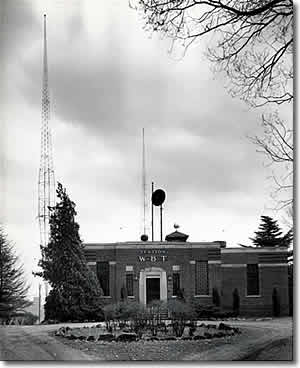 |
| Built in the late 1920s on Nations Ford Road, this old building still houses WBT's transmitter, now remotely controlled from the studios off W. Morehead Street. |
In 1947 a small transmitter licensed as KIA-55 was installed to send programs to the mountain for WBT-FM, which was housed in a rough wooden shack--the only building on Spencer Mountain. No telephone lines were available to the mountain. Later in 1947 this transmitter was also used to send programs and synchronization signals to the new WBT Satellite in Shelby, N. C. This KIA-55 has now been replaced by a smaller transmitter licensed as KID-99 which, with its twin KID-98 on Spencer Mountain, gets our signals over to Shelby.
In the fall of 1951, another addition to the transmitter building was begun, this time on the South side. It housed the new RCA type BTA 50F1 transmitter which was put into use early in the summer of 1952. The old 5A transmitter installed in 1928 and its big helper, the 50B, installed in 1932 (referred to as Old Betsy) have become obsolete, been remodeled and brought up to date and become obsolete again. Still, other than requiring a little more power, more spare parts, etc., they can do almost as good a job as this young whipper snapper, the RCA BTA 50F1.
Old Betsy still gets to flex her muscles in the wee hours of the night, 5 nights a week. She is tuned to 1240 Kilocycles, the Conelrad (National Defense) frequency, to keep the public informed in event of an air raid. But she can be put on 1110 Kilocycles in a few minutes if the need arises.
Photos courtesy Jim Scancarelli.
